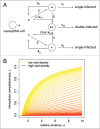Competition-colonization dynamics: An ecology approach to quasispecies dynamics and virulence evolution in RNA viruses
- PMID: 20798818
- PMCID: PMC2928310
- DOI: 10.4161/cib.3.4.11658
Competition-colonization dynamics: An ecology approach to quasispecies dynamics and virulence evolution in RNA viruses
Abstract
A single and purified clone of foot-and-mouth disease virus diversified in cell culture into two subpopulations that were genetically distinct. The subpopulation with higher virulence was a minority and was suppressed by the dominant but less virulent one. These two populations follow the competitioncolonization dynamics described in ecology. Virulent viruses can be regarded as colonizers because they killed the cells faster and they spread faster. The attenuated subpopulation resembles competitors because of its higher replication efficiency in coinfected cells. Our results suggest a new model for the evolution of virulence which is based on interactions between components of the quasispecies. Competition between viral mutants takes place at two levels, intracellular competition and competition for new cells. The two strategies are subjected to densitydependent selection.
Keywords: attenuation; densitydependent selection; fitness; foot-and-mouth disease virus; mutant spectrum; space-structured habitat.
Figures



Comment on
-
Competition-colonization dynamics in an RNA virus.Proc Natl Acad Sci U S A. 2010 Feb 2;107(5):2108-12. doi: 10.1073/pnas.0909787107. Epub 2010 Jan 13. Proc Natl Acad Sci U S A. 2010. PMID: 20080701 Free PMC article.
Similar articles
-
Competition-colonization trade-off promotes coexistence of low-virulence viral strains.J R Soc Interface. 2012 Sep 7;9(74):2244-54. doi: 10.1098/rsif.2012.0160. Epub 2012 Apr 18. J R Soc Interface. 2012. PMID: 22513722 Free PMC article.
-
Competition-colonization dynamics in an RNA virus.Proc Natl Acad Sci U S A. 2010 Feb 2;107(5):2108-12. doi: 10.1073/pnas.0909787107. Epub 2010 Jan 13. Proc Natl Acad Sci U S A. 2010. PMID: 20080701 Free PMC article.
-
The evolution of virulence in RNA viruses under a competition-colonization trade-off.Bull Math Biol. 2011 Aug;73(8):1881-908. doi: 10.1007/s11538-010-9596-2. Epub 2010 Nov 17. Bull Math Biol. 2011. PMID: 21082274
-
Minority report: hidden memory genomes in HIV-1 quasispecies and possible clinical implications.AIDS Rev. 2008 Apr-Jun;10(2):93-109. AIDS Rev. 2008. PMID: 18615120 Review.
-
Evolution of foot-and-mouth disease virus.Virus Res. 2003 Jan;91(1):47-63. doi: 10.1016/s0168-1702(02)00259-9. Virus Res. 2003. PMID: 12527437 Review.
Cited by
-
Haploflow: Strain-resolved de novo assembly of viral genomes.bioRxiv [Preprint]. 2021 Jan 26:2021.01.25.428049. doi: 10.1101/2021.01.25.428049. bioRxiv. 2021. Update in: Genome Biol. 2021 Jul 19;22(1):212. doi: 10.1186/s13059-021-02426-8. PMID: 33532769 Free PMC article. Updated. Preprint.
-
Differential Persistence of Foot-and-Mouth Disease Virus in African Buffalo Is Related to Virus Virulence.J Virol. 2016 Apr 29;90(10):5132-5140. doi: 10.1128/JVI.00166-16. Print 2016 May 15. J Virol. 2016. PMID: 26962214 Free PMC article.
-
Composition and Interactions of Hepatitis B Virus Quasispecies Defined the Virological Response During Telbivudine Therapy.Sci Rep. 2015 Nov 24;5:17123. doi: 10.1038/srep17123. Sci Rep. 2015. PMID: 26599443 Free PMC article.
-
Competition-colonization trade-off promotes coexistence of low-virulence viral strains.J R Soc Interface. 2012 Sep 7;9(74):2244-54. doi: 10.1098/rsif.2012.0160. Epub 2012 Apr 18. J R Soc Interface. 2012. PMID: 22513722 Free PMC article.
-
Virological and Immunological Outcomes of Coinfections.Clin Microbiol Rev. 2018 Jul 5;31(4):e00111-17. doi: 10.1128/CMR.00111-17. Print 2018 Oct. Clin Microbiol Rev. 2018. PMID: 29976554 Free PMC article. Review.
References
-
- Domingo E. Virus Evolution. In: Knipe DM, Howley PM, editors. Fields Virology. 5th ed. Philadelphia: Lappincott Williams & Wilkins; 2007. pp. 389–421.
-
- Tilman D, May RM, Lehman CL, Nowak MA. Habitat destruction and the extinction debt. Nature. 1994;371:65–66.
